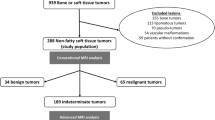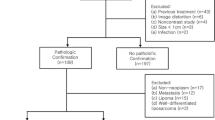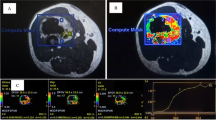Abstract
Objective
MRI is the most sensitive imaging modality in the staging, surgical planning, and following up of malignant soft tissue tumors. However, the ability of MRI to separate benign from malignant lesions is still of limited value for this purpose. We often observe that benign soft tissue tumors are accompanied by a peritumoral fat signal on MRI. The purpose of this study was to determine the value of the peritumoral fat signal in separating benign from malignant soft tissue tumors.
Materials and methods
We retrospectively reviewed 121 patients with soft tissue tumors (52 men, 69 women; median age 54 years). Two musculoskeletal oncologists reviewed the MRI independently and reported on the presence or absence of a peritumoral fat signal. The sensitivity, specificity, and the positive and negative predictive values of the peritumoral fat signal for the prediction of benignancy of soft tissue tumors were calculated.
Results
Peritumoral fat signals were identified in 54 of 64 (84.3 %) benign and 10 of 57 (17.5 %) malignant tumors (p < 0.01). This result had a sensitivity of 84.4 %, specificity of 82.5 %, PPV of 84.4 %, and NPV of 82.5 %.
Conclusion
This study permits the conclusion that the presence of peritumoral fat signals is seemingly an exceptional finding in malignant soft tissue tumors. Observation of this peritumoral fat signal should accordingly influence the management of soft tissue tumors.


Similar content being viewed by others
References
Anil G, Tan TY (2010) Imaging characteristics of schwannoma of the cervical sympathetic chain: a review of 12 cases. Am J Neuroradiol 31:1408–1412
Anil G, Tan TY (2011) CT and MR evaluation of nerve sheath tumors of the cervical vagus nerve. AJR 197:195–201
Bancroft LW, Kransdorf MJ, Menke DM, O'Connor MI, Foster WC (2002) Intramuscular myxoma: characteristic MR imaging features. AJR 178:1255–1259
Berquist TH, Ehman RL, King BF, Hodgman CG, Ilstrup DM (1990) Value of MR imaging in differentiating benign from malignant soft-tissue masses: study of 95 lesions. AJR 155:1251–1255
Bongartz G, Vestring T, Peters PE (1992) Magnetic resonance tomography of soft tissue tumors. Radiologe 32:584–590
Cerofolini E, Landi A, De Santis G, Maiorana A, Canossi G (1991) MR of benign peripheral nerve sheath tumors. J comput Assist Tomogr 15:593–597
Chen CK, Wu HT, Chiou HJ, Wei CJ, Yen CH, Chang CY, Chen WM (2009) Differentiating benign and malignant soft tissue masses by magnetic resonance imaging: role of tissue component analysis. J Chin Med Assoc 72:194–201
Crim JR, Seeger LL, Yao L, Chandnani V, Eckardt JJ (1992) Diagnosis of soft-tissue masses with MR imaging: can benign masses be differentiated from malignant ones? Radiology 185:581–586
Datir A, James SL, Ali K, Lee J, Ahmad M, Saifuddin A (2008) MRI of soft-tissue masses: the relationship between lesion size, depth, and diagnosis. Clin Radiol 63:373–380
De Schepper AM, Bloem JL (2007) Soft tissue tumors: grading, staging, and tissue-specific diagnosis. Top Magn Reson Imaging 18:431–444
FletcherCDM, Unni KK, Mertens F, eds (2002) World Health Organization Classification of Tumors. Pathology and genetics of tumors of soft tissue and bone. Lyon, France:IARC. p.102–103
Hermann G, Abdelwahab IF, Miller TT, Klein MJ, Lewis MM (1992) Tumour and tumour-like conditions of the soft tissue: magnetic resonance imaging features differentiating benign from malignant masses. Br J Radiol 65:14–20
Kransdorf MJ, Jelinek JS, Moser RPJ, Utz JA, Brower AC, Hudson TM, Berrey BH (1989) Soft-tissue masses: diagnosis using MR imaging. AJR 153:541–547
Li CS, Huang GS, Wu HD, Chen WT, Shih LS, Lii JM, Duh SJ, Chen RC, Tu HY, Chan WP (2008) Differentiation of soft tissue benign and malignant peripheral nerve sheath tumors with magnetic resonance imaging. Clin Imaging 32:121–127
Liu L, Wu N, Ouyang H (2011) Diagnostic value of delineating deep fascia in distinguishing between benign and malignant soft-tissue tumors in lower limbs using 3.0 T magnetic resonance imaging. J Magn Reson Imaging 33:173–179
Murphey MD, McRae GA, Fanburg-Smith JC, Temple HT, Levine AM, Aboulafia AJ (2002) Imaging of soft-tissue myxoma with emphasis on CT and MR and comparison of radiologic and pathologic findings. Radiology 225:215–224
Murphey MD, Smith WS, Smith SE, Kransdorf MJ, Temple HT (1999) From the archives of the AFIP. Imaging of musculoskeletal neurogenic tumors: radiologic-pathologic correlation. RadioGraphics 19:1253–1280
Penna C, Tiret E, Parc R, Sfairi A, Kartheuser A, Hannoun L, Nordlinger B (1993) Operation and abdominal desmoid tumors in familial adenomatous polyposis. Surg Gynecol Obstet 177:263–268
Petasnick JP, Turner DA, Charters JR, Gitelis S, Zacharias CE (1986) Soft-tissue masses of the locomotor system: comparison of MR imaging with CT. Radiology 160:125–133
Sen J, Agarwal S, Singh S, Sen R, Goel S (2010) Benign vs malignant soft tissue neoplasms: limitations of magnetic resonance imaging. Indian J Cancer 47:280–286
Conflict of interest statement
Each author certifies that they have no commercial associations that might pose a conflict of interest in connection with the submitted article.
Ethical review committee statement
This study did not receive institutional review board approval because our institution does not require such approval for retrospective studies.
Author information
Authors and Affiliations
Corresponding author
Rights and permissions
About this article
Cite this article
Murahashi, Y., Kaya, M., Mizushima, E. et al. Does the peritumoral fat signal on MRI exclude malignancy of soft tissue tumor?. Eur Orthop Traumatol 5, 241–245 (2014). https://doi.org/10.1007/s12570-013-0241-z
Received:
Accepted:
Published:
Issue Date:
DOI: https://doi.org/10.1007/s12570-013-0241-z




